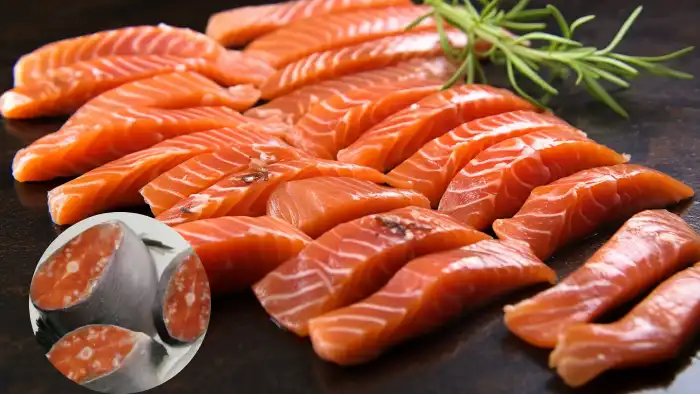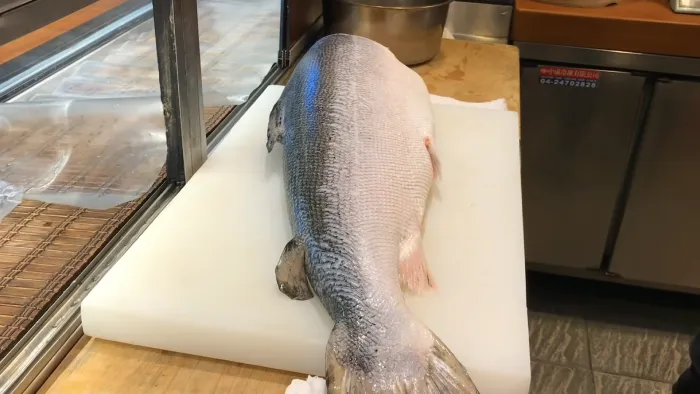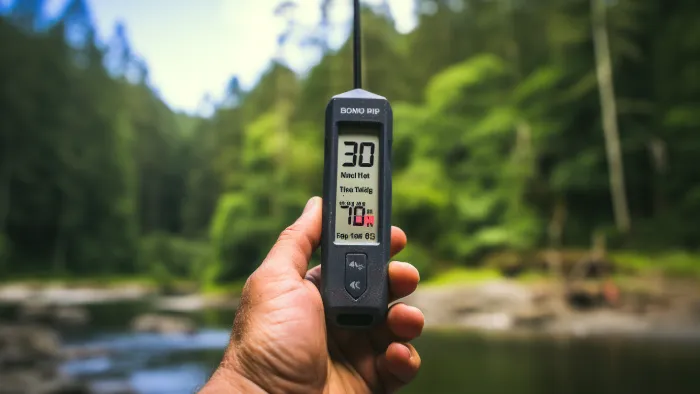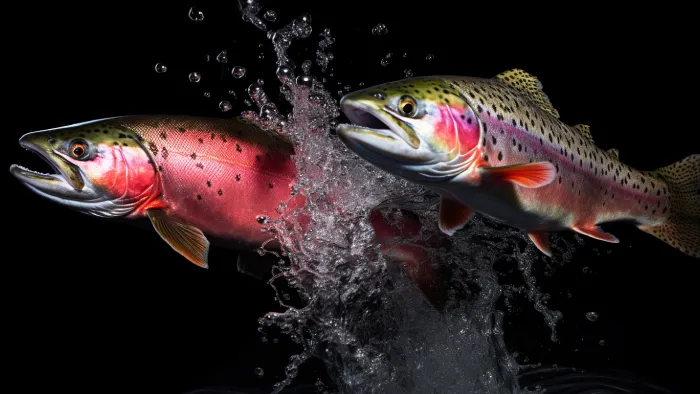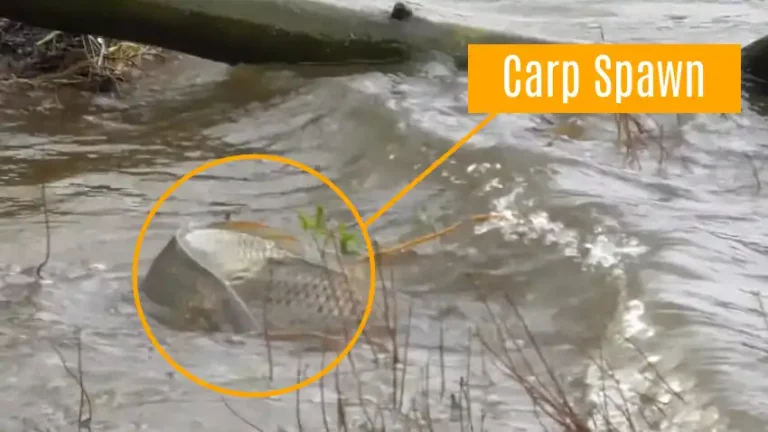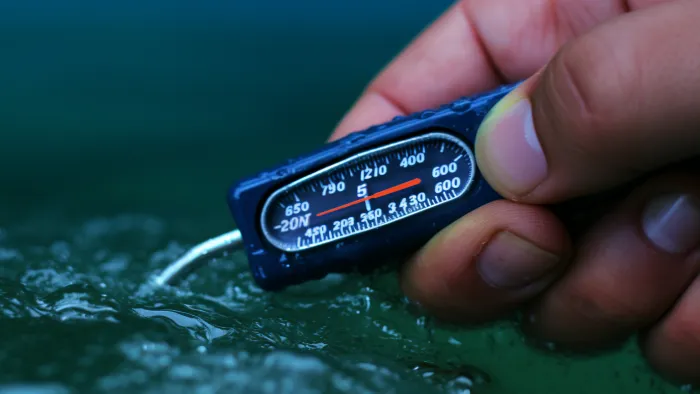Does All Salmon Have Worms: Know 4 Species before Fly Fishing
When you catch salmon during your fly fishing adventures, one question that might cross your mind is, “Does all salmon have worms?”
Not every salmon you reel in will be afflicted by worms. But, you need to know that certain salmon species are more susceptible to these parasites due to their life cycle and habitat.
When fly fishing, you’ll find that worms are more likely to be found in wild-caught salmon, especially those that have spent a lot of time in freshwater.
On the other hand, the controlled diets and environments of farm-raised salmon, which fly fishermen might not as frequently target, tend to result in fewer worm infestations.
We’ll talk about which salmon species are affected by worms in fly fishing, how to tell if your salmon fish have worms, and how to kill them.
Does All Salmon Have Worms: Four Species to Know Before Fly Fishing
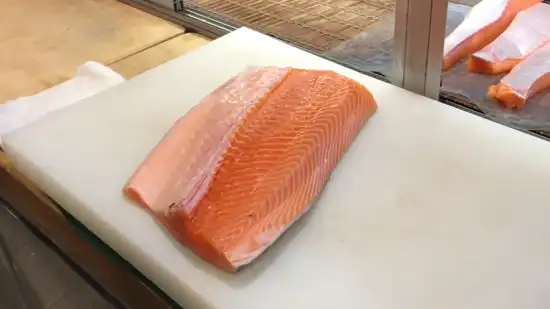
During fly fishing, you might encounter several species of salmon that can be affected by worms, particularly the following:
- Sockeye salmon (Oncorhynchus nerka)
- Coho salmon
- Chinook salmon (Oncorhynchus tshawytscha)
- Pink salmon and chum salmon
Let’s take a closer look at all the salmon species that are affected by worms.
1. Sockeye Salmon (Oncorhynchus Nerka)
You might want to know that Sockeye Salmon can carry pseudobranchicola, a type of worm, and can also harbor Japanese tapeworm infections.
Pseudobranchicola is a parasitic worm that can infest the gill filaments of Sockeye Salmon, causing significant damage to its respiratory system.
These worms are commonly found in the gill chambers and can lead to respiratory distress, reduced oxygen uptake, and compromised overall health.
In addition, Sockeye Salmon can also be infected with Japanese tapeworms, scientifically known as Diphyllobothrium nihonkaiense.
These tapeworms can infect the salmon’s intestines, leading to gastrointestinal symptoms such as diarrhea, abdominal pain, and malabsorption of nutrients.
It is important to note that while these worms can be present in Sockeye Salmon, proper cooking and freezing can effectively kill them, ensuring safe consumption.
2. Coho Salmon
If you plan to eat Coho Salmon, you should be aware that they can carry pseudobranchicola worms and Japanese tapeworm infections, just like Sockeye Salmon.
Pseudobranchicola worms are parasites that reside in the gill filaments of the salmon. They can cause damage to the gills and impair the fish’s ability to breathe.
On the other hand, Japanese tapeworm infections are caused by ingesting larvae in raw or undercooked salmon.
3. Chinook Salmon (Oncorhynchus Tshawytscha
When consuming Chinook Salmon, it’s crucial to be aware of the potential presence of pseudobranchicola worms and Japanese tapeworm infections, similar to other types of salmon.
Pseudobranchicola worms are parasitic organisms that can infect the gills of Chinook Salmon.
On the other hand, Japanese tapeworm infections can occur in the flesh and intestines of the salmon. These tapeworms can grow several meters in length and cause digestive problems in humans if consumed.
4. Pink Salmon and Chum Salmon
Pink and Chum Salmon, just like Chinook Salmon, can also be carriers of pseudobranchicola worms and Japanese tapeworm infections, posing potential health risks to humans if consumed raw or undercooked.
Pseudobranchicola worms are parasites that can infect the gills and respiratory system of these salmon species.
Japanese tapeworm infections, caused by the parasite Diphyllobothrium nihonkaiense, can occur when raw or undercooked salmon are consumed.
How Do You Determine if Your Salmon Fish Caught During Fly Fishing Has Worms?
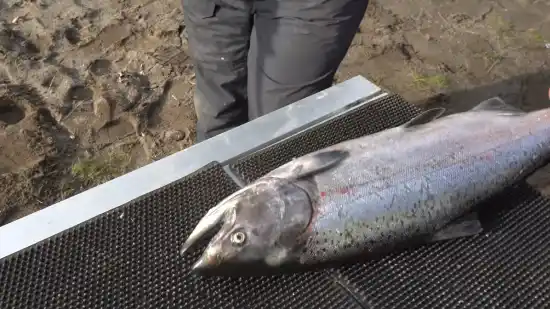
To determine whether your salmon fish caught while fly fishing contains worms, there are several methods you can use.
1. Visual Inspection
Inspect the salmon’s flesh for any visible worms or cysts while cleaning your catch. This visual inspection is crucial in determining if the salmon you caught while fly fishing is infested with worms. Here are four key factors to consider during the inspection:
- Color: Healthy salmon flesh should have a vibrant pink or orange color. If you notice any unusual discoloration, it could indicate the presence of parasites.
- Texture: The flesh should be firm and have a smooth texture. Any lumps, bumps, or visible cysts may be signs of worm infestation.
- Translucency: Hold the flesh up to the light and observe its translucency. Worms or cysts may appear as dark spots or threads within the flesh.
- Movement: Gently press on the flesh and watch for any movement. If worms or cysts are present, they may wiggle or squirm.
2. Smell Test
When cleaning your catch, make sure to give the salmon flesh a good sniff to detect any unusual odors that could indicate contamination.
A fresh salmon should have a mild, pleasant smell. However, if you detect an unusual odor, it could be a sign of contamination.
The smell test is an important step in ensuring the quality and safety of your catch. Contamination can occur due to various factors, such as improper handling, storage, or exposure to pollutants in the water. Using your sense of smell, you can identify potential issues and take necessary precautions.
If you notice a strong, foul odor, it is best to avoid consuming the fish and consult a professional for further guidance. Remember, a healthy and fresh salmon should have a clean and appetizing scent.
3. Texture Check
While preparing to cook your catch, gently press the salmon flesh with your fingers to ensure it feels firm and resilient, as any unusual texture may indicate the presence of worms. This texture check is an important step in determining the quality and safety of your salmon.
Here are four key things to look out for:
- Firmness: The flesh of a healthy salmon should feel firm to the touch. It could be a sign of worms if it feels soft or mushy.
- Resilience: When you press down on the flesh, it should bounce back quickly. A lack of resilience may indicate the presence of parasites.
- Smoothness: Run your fingers along the surface of the salmon. It should feel smooth and free from any lumps or bumps. The rough or uneven texture could be a sign of worms.
- Consistency: The texture of the salmon should be consistent throughout. If you notice any areas that feel different or have a strange texture, it’s best to discard the fish to avoid any potential health risks.
4. Fish Candling
If you have the equipment, you can hold a light beneath the fillet to check for any visible worms or cysts. This method, known as fish candling, is useful for detecting parasites that may not be easily seen with the naked eye.
By shining a light through the flesh of the salmon, you can observe any abnormalities or signs of infestation.
The light will pass through the translucent bodies of worms or cysts, making them visible against the backdrop of the filet. This method is commonly used in the seafood industry to ensure the quality and safety of fish products.
Despite this, remember to note that not all salmon will have worms or cysts, as the presence of parasites can vary depending on factors such as the origin and handling of the fish.
How Do You Kill Worms in Salmon Caught After Fly Fishing?
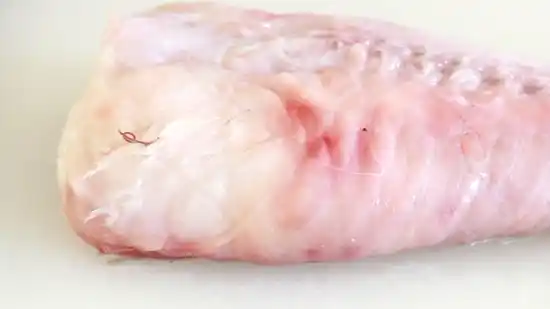
When it comes to killing worms in salmon caught during fly fishing, you can use several effective methods. The following are among them:
1. Freezing
Freezing salmon at -20°C (-4°F) or below for at least 7 days can effectively kill most parasites, making it safe to consume. Here are four reasons why freezing is an effective method for killing parasites in salmon:
- Low temperatures: Freezing salmon at -20°C (-4°F) or below creates an inhospitable environment for parasites. Cold temperatures can slow down or even halt the growth and reproduction of parasites, ultimately leading to their death.
- Duration: Filling salmon for at least 7 days is important to ensure that all parasites are effectively killed. This duration allows enough time for the low temperatures to penetrate the fish and eliminate any potential parasites.
- Uniform freezing: Ensuring the salmon is frozen evenly throughout is crucial. This can be achieved by properly packaging and storing the fish, ensuring it is consistently exposed to low temperatures.
- Safe consumption: By effectively killing parasites through freezing, salmon becomes safe to consume, reducing the risk of parasitic infections in humans. Properly frozen salmon can be enjoyed with peace of mind, knowing that it has undergone a scientifically proven method of parasite elimination.
2. Cooking
To ensure the safety of your fish, you need to cook salmon to an internal temperature of 145°F (63°C) to kill any parasites. Cooking at this temperature eliminates any potential health risks of consuming raw or undercooked salmon.
When salmon is properly cooked, the heat destroys any parasites that may be present, including the microscopic worms that can sometimes be found in fish.
These parasites, such as the Anisakis simplex worm, can cause gastrointestinal discomfort and allergic reactions in humans if ingested alive.
3. Chemical Treatment
Some commercial seafood is treated with chemicals to eliminate parasites. One such chemical treatment is the use of carbon monoxide (CO) to preserve the color and appearance of fish.
Carbon monoxide can also have anti-parasitic effects, but its use in food has raised concerns related to consumer safety and potential health risks.
Regulatory authorities in various countries have set limits on the use of carbon monoxide in seafood products, and its application is subject to strict guidelines.
However, due to the potential risks and regulatory complexities, chemical treatments are not as widely adopted as freezing and cooking methods for parasite elimination in salmon.
What percentage of wild salmon has worms?
Approximately 75% of filets from wild-caught salmon have been found to contain parasitic worms.
Moreover, the prevalence of parasites in some wild-caught fish reaches even higher levels, with estimates suggesting that over 90% of these fish may be infected with at least parasite eggs.
These figures highlight the importance of proper handling, freezing, and cooking techniques to ensure the safety of consuming wild-caught salmon and other fish.
What happens if you eat salmon with worms?
You might ingest nematode larvae if you consume salmon with worms, particularly by eating raw or undercooked infected fish. These larvae can enter your gastrointestinal tract, leading to potential health issues.
The presence of these parasites results in inflammation in the esophagus, stomach, or intestine. However, you need to note that consuming properly prepared fish, which has been adequately frozen and cooked, significantly reduces the risk of encountering live worms.
The good news is that these worms are not transmissible between people, and if you swallow a live parasitic worm, it might not cause illness as long as it passes through the digestive system and gets excreted.
Cook Your Fly-Fished Salmon with Care for Delicious, Worm-Free Meals
It is now clear that not all salmon encountered during your fly fishing escapades carry worms. Certain species of salmon, like Sockeye, Coho, Chinook, Pink, and Chum, are more vulnerable to parasites because of their habitat and life cycle.
While worms are more common in wild-caught salmon, farm-raised salmon generally have fewer worm infestations due to controlled environments.
You can determine if your catch has worms by using visual inspection, the smell test, texture checks, and even fish candling.
To ensure safe consumption, thoroughly freezing and cooking your salmon are essential steps. With these precautions, you can enjoy the delicious taste of salmon while you fly fish without any work-related worries.

